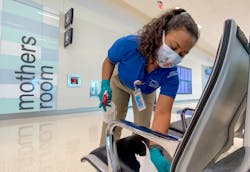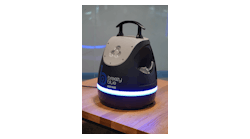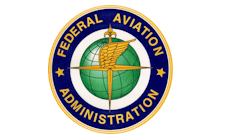The SARS-CoV-2 (COVID-19) changed the world and the way people interact with it. And just as it looked as though the world might return to pre-pandemic normalcy, the delta variant of the virus is causing caution to remain. The change in how airports approach facility maintenance from pre- to post-pandemic is here to stay, but lessons have been learned along the way.
“Initially our attention shifted to the latest CDC guidelines and making sure we were following them,” recalled Dawn Hoffman, assistant director, terminal management for Houston Airports. “Through the last year and a half now things have changed and we had to make sure we were always in tune with the latest health and safety guidelines from the pertinent authorities. As an organization we had to make sure we were in contact with the CDC and implementing measures to protect our passengers and employees.”
Hoffman added that they continue to have airport team members participate in all of their airport and airline meetings.
“That includes our federal partners, so we are in continuous contact to make sure we are all following those guidelines and recommendations. As far as we are concerned in terminal management, we are not coming out of the pandemic yet and we must continue to be vigilant in how we proceed with the cleaning and maintenance of our terminals. We are not going back to an aesthetics-based approach,” she said.
That aesthetics-driven approach is how Houston Airports strategized their facility maintenance prior to the pandemic. Cleanliness was still key and as Hoffman described, they were taking steps to technologically improve their operations before COVID-19.
“Not too long ago, pre-COVID, we installed the smart restrooms and that technology allowed us to receive passenger feedback, thereby improving the overall passenger experience. It also provided real-time data for maintenance and management but again, our approach to cleaning and maintaining the terminal was aesthetics-based,” she said.
But it was cleanliness from a visual and passenger experience perspective more than a germ-mitigation perspective.
“Before the pandemic it was about the areas looking good, providing a pleasant experience, a terminal that smells nice and was aesthetically appealing,” Hoffman said. “A passenger’s experience in our airport affects their stress levels, their willingness to spend at our concessions and their desire to return to our airport, all which are very important to us. And I would say, out of all of the components from the passenger journey, nothing holds more weight than cleanliness. You will lose a passenger if you do not have a clean airport.”
Now it’s all about keeping them happy and safe.
“Knowing that they could come into contact with something that could have a huge impact on their health made us shift our strategy. The seriousness of our cleaning practices and terminal maintenance practices took a giant leap. Our approach evolved from that,” Hoffman said.
The New Plan
The shift in approaches made Houston Airports investigate new directions and areas they had never considered before.
“We never had thought about ‘fogging’ anything before the pandemic or having cleaning robots as part of our staff. So definitely the use of new technology for cleaning the terminal is the most notable trend that has come about during the pandemic,” Hoffman said.
Technological upgrades were needed to meet their new focus on high-frequency disinfecting at all the passenger touchpoints throughout the passenger journey.
“We had to look at our equipment. We were flooded with recent innovations and cleaning technologies. So we undertook looking at all of those, deciding what would work at our airport and benefit our passengers, then making changes with procurement. We never had cleaning technology as a priority on our business plan, so immediately that changed. In the initial stage of the pandemic we implemented handheld foggers to disinfect passenger areas,” said Hoffman.
Houston Airports quickly added UV to their autonomous floor scrubbers, allowing them to effectively disinfect floors using the robots that were already operating in the terminal. More recently, the airports have added additional robots – the Breezy One – that autonomously disinfect areas used by passengers.
Not everything the airport tried worked in the long run, however.
“There were other options that didn’t work out, either because they were cost-prohibitive or because of the time it would take to implement them. Some other technology that would work well, for instance in a hospital environment, would not be as well-received or effective in an airport environment,” Hoffman said.
Learning and continually adapting to the changing pitches of the pandemic has been one of the greatest challenges, Hoffman said.
“Our biggest challenge was knowledge - educating staff about the changes the pandemic brought on. We had to review and update all of our Standard Operating Procedures (SOPs), we had to train our custodial staff on these new practices and emphasize the paradigm shift that now we are not only cleaning, but we are safeguarding passengers’ and employees’ health,” she said.
Hoffman added that, for example, if the cleaning agent requires a dwell time of one minute and requires that you spray it directly onto the surface and not onto the cloth initially to be effective, they had to make sure the instructions were followed each and every time.
“These changes are critical to the effectiveness of the cleaning, so the procedures had to be reviewed and updated, and we had to have intensive training sessions to make sure all our staff members followed them appropriately,” she continued.
Another challenge was not just learning for themselves but then conveying what they learned and putting best practices into place for the passengers, making sure they were knowledgeable and felt safe returning to the airport.
“We spent a lot of time with our airline tenants and with our airport communications team getting the word to the public of all our efforts. Our communications team produced videos highlighting our new cleaning technology, as well as the daily efforts of our custodial teams. FlySafe Houston was born and that is how Houston Airports communicated externally the health and safety program that was in place at both Bush and Hobby airports. Terminal cleaning was at the forefront of the award-winning and internationally accredited FlySafe Houston campaign,” Hoffman explained.
Partnerships for Success
Hoffman said that outside of updating their SOPs, they began Adenosine triphosphate (ATP) testing to validate their work.
“This testing helped us determine if our new procedures were effective, if we were achieving the results we wanted. We connected with concessionaires, airlines and different vendors. We identified high touchpoint areas in the terminals and we applied the ATP test. This test determines how effective our new cleaning SOPs were, so we could implement what gave us the best results and abandon other practices. This testing was key in helping us and our partners prioritize certain cleaning practices over others,” Hoffman said.
The constant communication that Houston Airports had with their vendors and airline partners, all working together with the CDC, proved to be an invaluable approach and helped them from responding with knee-jerk reactions to events as the unfolded. As Hoffman said, they knew that nothing would be the same after COVID and making the right decisions and sticking with them was, and is, key.
“Working together with the CDC and all our airport partners helped us decide what was the best approach and not just have a knee-jerk reaction to something we couldn’t maintain. We knew we had to sustain our decisions on new cleaning protocols; we knew this wasn’t going to be for a short period. From early on we knew COVID would forever change our profession,” she said.
Without the partnerships and the constant communication, Hoffman said Houston Airports wouldn’t have been successful.
“After feeling COVID’s complete disruption of our industry and leading our team through it all I think it’s imperative to be a part of, to contribute and stay vocal on state and national levels within our industry. Going through COVID, certainly an unforeseen event that felt like it changed the industry overnight, would’ve been impossible to overcome individually. We need those connections, that support and that network to successfully get through something as disruptive as the COVID-19 pandemic,” Hoffman said.
During the pandemic’s toughest times, Hoffman said she was speaking with counterparts from across the nation on how best to overcome the obstacles.
“Our networking and support within the airport community grew exponentially since then. COVID-19 has had a big impact on the travel industry and airports around the world but it also made our community much more resilient and tight-knit. I’m sure airports will continue to be at the forefront of the recovery if we continue to work together and prioritize passengers’ health and well-being during these challenging times,” she said.





